When wildfires spread into communities, they can burn cars, homes, and all kinds of materials surrounding them—electronics, paint, plastics, furniture.
Studies have shown that the mixture of chemicals released when such man-made materials burn is different from that released during vegetation fires, and may be more toxic. Smoke and ash can blow under doors and around windows in nearby homes, bringing in chemicals that are absorbed by furniture, walls and other indoor surfaces and continue to outgas for weeks to months.
When people return to smoke-damaged homes after wildfires, there are several steps they can take to protect their health before beginning cleaning.
Elevated levels of metals and volatile organic compounds
After the Marshall Fire tore through communities near Boulder, Colorado, in 2021, my colleagues at the University of Colorado and the Laboratory and I heard from many residents who were concerned about the ash and lingering ash left in their homes. The smell, and these houses survived the fire.
In the homes my colleagues were able to quickly test, they found elevated levels of metals and PAHs (polycyclic aromatic hydrocarbons) in the ash. We also found elevated levels of VOCs (volatile organic compounds) in air samples. Some volatile organic compounds, such as dioxins, benzene, formaldehyde, and polycyclic aromatic hydrocarbons, can be toxic to humans. Benzene is a known carcinogen.

At the time, we could find no information on the physical health effects of people returning to smoke-damaged homes after wildfires. So, to look for patterns, we surveyed fire-affected residents six months, one year and two years after the fires.
Even six months after the fire, we found that many people were reporting symptoms related to the health risks associated with fire smoke and ash.
More than half (55%) said they experienced at least one symptom six months after the Marshall Fire. The most common symptoms were itchy or watery eyes (33%), headache (30%), dry cough (27%), sneezing (26%) and sore throat (23%).
All of these symptoms, along with a strange taste in the mouth, coincide with people reporting that their homes smelled different when they returned home a week after the fire.
Many respondents stated that the smell decreased over time. Most people attribute improvement in odor to time, cleaning surfaces and air ducts, changing furnace filters, and removing carpets, textiles, and furniture from their home. Despite this, many people still experience symptoms.
We also found that living near a large number of burned buildings was associated with these health symptoms. We found that for every 10 destroyed buildings within 820 feet (250 meters) of a person's home, there was a 21% increase in headaches and a 26% increase in bad taste in the mouth.
These symptoms were consistent with exposure to chemicals we found in the ash and measured in the air inside the few smoke-damaged homes we were able to study in depth.
Lingering symptoms and problems
There are still many unanswered questions about the health risks posed by homes damaged by smoke and ash.
For example, we don’t yet know what the long-term health effects might look like for people whose homes contain wildfire smoke and ash residue gases. We found a significant decrease in the number of people reporting symptoms one year after the fire. However, 33% of those whose homes were affected and later surveyed still reported at least one symptom they attributed to the fire. About the same proportion also reported at least one symptom two years after the fire.
We also cannot measure the levels of VOCs or metals that each person is exposed to. But we do believe that reports of changes in odors in homes a week after the fire indicate that VOCs may be present in the home. This could have health consequences for people whose homes are exposed to wildfire smoke or ash.
Tips to protect yourself after a wildfire
Wildfires are increasingly destroying homes and other structures as more people move into the wildland-urban interface, temperatures rise and fire seasons lengthen.
If your home survived a nearby wildfire, here are some steps to consider before you start cleaning:
When you're ready to clean your home, start by protecting yourself. Wear at least an N95 (or KN95) mask, gloves, goggles, and clothing that covers your skin. Cleaning may re-release some of these gases and ash into the air.
Keep people with heart or lung disease, the elderly, pregnant women, children and pets away from cleanup activities.
Vacuum floors, curtains and furniture. A recent scientific study documented how cleaning all surfaces within the home reduces the storage of VOCs and lowers the concentration of VOCs in indoor air. After the outdoor air is purified, open the windows to let in the clean air.
Avoid using harsh chemical cleaners as they can react with the chemicals in the ash.
Clean HVAC filters and ducts to avoid further spreading of ash, and replace filters monthly until the odor disappears. Portable air purifiers with carbon filters can help remove VOCs and particulate matter.
If your car smells like smoke, consider replacing your cabin air filter.
This is an update to an article first published on December 23, 2024.